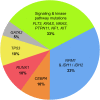Recent Treatment Advances and the Role of Nanotechnology, Combination Products, and Immunotherapy in Changing the Therapeutic Landscape of Acute Myeloid Leukemia
- PMID: 31236772
- PMCID: PMC6591181
- DOI: 10.1007/s11095-019-2654-z
Recent Treatment Advances and the Role of Nanotechnology, Combination Products, and Immunotherapy in Changing the Therapeutic Landscape of Acute Myeloid Leukemia
Abstract
Acute myeloid leukemia (AML) is the most common acute leukemia that is becoming more prevalent particularly in the older (65 years of age or older) population. For decades, "7 + 3" remission induction therapy with cytarabine and an anthracycline, followed by consolidation therapy, has been the standard of care treatment for AML. This stagnancy in AML treatment has resulted in less than ideal treatment outcomes for AML patients, especially for elderly patients and those with unfavourable profiles. Over the past two years, six new therapeutic agents have received regulatory approval, suggesting that a number of obstacles to treating AML have been addressed and the treatment landscape for AML is finally changing. This review outlines the challenges and obstacles in treating AML and highlights the advances in AML treatment made in recent years, including Vyxeos®, midostaurin, gemtuzumab ozogamicin, and venetoclax, with particular emphasis on combination treatment strategies. We also discuss the potential utility of new combination products such as one that we call "EnFlaM", which comprises an encapsulated nanoformulation of flavopiridol and mitoxantrone. Finally, we provide a review on the immunotherapeutic landscape of AML, discussing yet another angle through which novel treatments can be designed to further improve treatment outcomes for AML patients.
Keywords: acute myeloid leukemia; immunotherapy; liposomes; nanotechnology.
Figures
References
-
- Estey E, Dohner H. Acute myeloid leukaemia. Lancet. 2006;368(9550):1894–1907. - PubMed
-
- Lowenberg B, Downing JR, Burnett A. Acute myeloid leukemia. N Engl J Med. 1999;341(14):1051–1062. - PubMed
-
- Szotkowski T., Rohon P., Zapletalova L., Sicova K., Hubacek J., Indrak K. Secondary acute myeloid leukemia – a single center experience. Neoplasma. 2010;57(2):170–178. - PubMed
Publication types
MeSH terms
Substances
LinkOut - more resources
Full Text Sources
Medical
Miscellaneous




